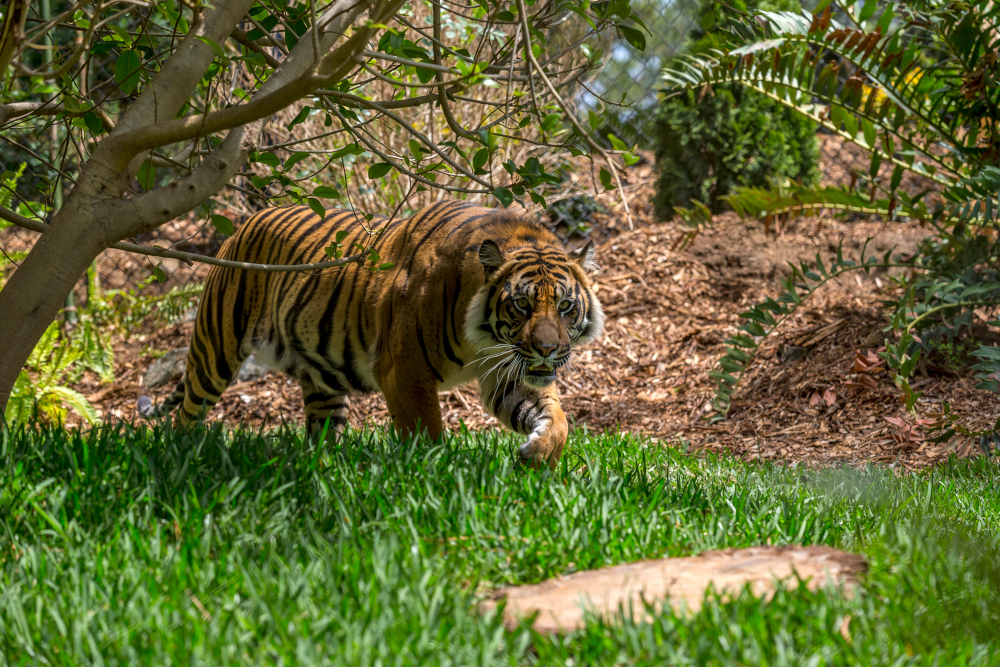Species name:
Sumatran tiger (Panthera tigris sumatrae or sondaica)
Description:
The Sumatran tiger is the world’s smallest tiger subspecies* but still the largest predator in Indonesia. An adult female weighs about 198 pounds (90 kg), while an adult male can be more than 264 pounds (120 kg), with a shoulder height of about 23 inches (60 cm). Sumatran tigers have great day and night vision, very strong canine teeth, and impressive claws for holding and gripping moving prey. Their vision is six times better than humans’ at night, but hearing is their most acute sense, mainly used for hunting. They can detect high-pitched sounds produced by prey. Each individual Sumatran tiger has nearly 100 unique stripe patterns, like human fingerprints, which provide camouflage. Based on these stripes, scientists can identify individual tigers in the wild.
* (Editor’s note: Tiger subspecies remain a matter of ongoing scientific discussion.)
Where it’s found:
Endemic to the island of Sumatra, this predator still lives in 24 of 38 landscapes larger than 96 square miles (250 square km), the smallest area that can support a breeding unit.
IUCN Red List status:
Endangered at the species level of Panthera tigris. Assessment for all subspecies, including Sumatran tigers, has been discharged by the International Union for the Conservation of Nature awaiting further reassessments. Detail about Sumatran tiger status, however, is provided in the supplementary material of the assessment.

Major threats:
Conflict between tigers and humans and illegal poaching and trafficking remain the most pressing threat to these big cats. Meanwhile rapid forest loss has left their habitat fragmented. Agriculture, the main driver of deforestation, contributed to an estimated loss of 27% of tropical forests across the island between 2000 and 2016. With demand for products such as palm oil, coffee and timber only increasing, this trend will continue.
Notable conservation programs or legal protections:
The Sumatran tiger is legally protected by the government of Indonesia through the Law No. 5 of 1990 regarding the Conservation of Natural Resources and Ecosystems. Key conservation priorities include:
-
- Strengthening the capacity of Sumatran tiger conservation through research – exploration, knowledge management, and training and education.
- Increasing the effectiveness of tiger landscape management in both major landscapes and marginal habitats.
- Strengthening the protection of tigers from habitat destruction, poaching, and conflict through effective patrols and law enforcement.
- Strengthening networks and partnerships for conservation that increase mutual benefits, supports, and added value to the community and stakeholders.
- Improving infrastructure and strengthening human-tiger conflict mitigation to save problem tigers and threatened populations.
- Increasing permeability and connectivity between habitat clusters in fragmented habitats.
My favorite experience:
I have been studying the Sumatran tiger using camera traps since 1998. Discovering tigers and other wildlife species, especially those with low detection probabilities, has always been my favorite experience. Together with the San Diego Zoo, where I’m a research fellow, I also learned many interesting new things related to technology in wildlife conservation, including the use of GPS collars, thermal drones, and new analytical techniques to strengthen the management of the Sumatran tigers and other key wildlife. As a senior manager, I’ve also had an opportunity to build and enhance the capacity of young people to become a new generation in Sumatran tiger and wildlife conservation.
What else do we need to understand or do to protect this species?
We need studies on potential connectivity among Sumatran tiger landscapes, with an emphasis on the roles of marginal habitats; nature-based solutions to strengthen active involvement of forest-edge communities in Sumatran tiger and key wildlife conservation; and technologies to enhance the capacity of forest rangers to prevent and detect illegal hunting on the tiger and principal prey.
Key research:
-
- Goodrich, J., H. T. Wibisono, D. Miquelle, A. Lynam, E. Sanderson, S. Chapman, T. N. E. Gray, A. Harihar, P. Chanchani. 2022. Panthera tigris: IUCN Redlist status update. Catnews, 76: 12 – 13.
- Goodrich, J., H. T. Wibisono, D. Miquelle, A. Lynam, E. Sanderson, S. Chapman, T. N. E. Gray, A. Harihar, P. Chanchani. 2022. Panthera tigris. In The IUCN Red List of Threatened Species DOI: https://dx.doi.org/10.2305/IUCN.UK.2022-1.RLTS.T15955A214862019.en
- Wibisono, H. T. 2021. An Island-Wide Status of Sumatran tiger (Panthera Tigris Sumatrae) and Principal Prey in Sumatra, Indonesia. A Ph.D Dissertation, Department of Entomology and Wildlife Conservation, College of Agriculture and Natural Resources, University of Delaware, DE, US. https://udspace.udel.edu/items/c86c7184-8214-463b-ad51-f5da61b98132
Previously in The Revelator:
Tigers and Wolves: The Reigning Cats and Dogs in Conservation?
![]()


